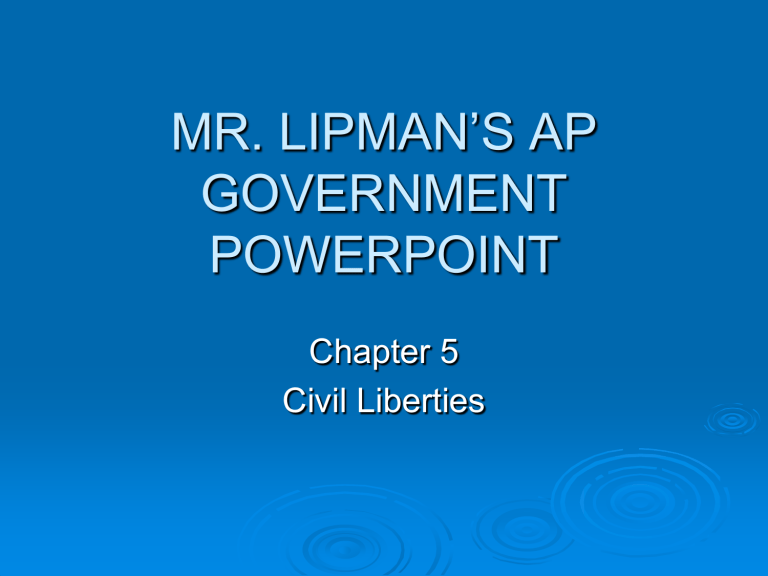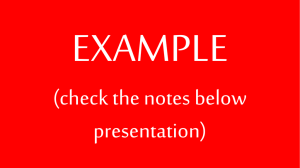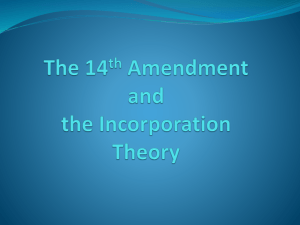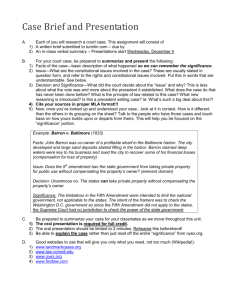APGOV Power Point 5

MR. LIPMAN’S AP
GOVERNMENT
POWERPOINT
Chapter 5
Civil Liberties
Civil Liberties emanate from the Bill of
Rights and are designed to place restrictions on what the Government can do.
Civil Rights emante from the Civil War amendments (13, 14 and 15) and are designed to provide protections for citizens.
Doctrine of Selective Incorporation
Barron v. Baltimore (1833)
Gitlow v. New York (1925) becomes the first to mention the possibility of it.
Near v. Minnesota (1931) becomes the first to use it.
Gitlow v. New York (1925) essentially overturned the precedent established in what case?
A.
Dred Scott v. Sanford (1857)
B.
McCulloch v. Maryland (1819)
C.
Barron v. Baltimore (1833)
D.
Gibbons v. Ogden (1824)
E.
Marbury v. Madison (1803)
Gitlow v. New York (1925) essentially overturned the precedent established in what case?
A.
Dred Scott v. Sanford (1857)
B.
McCulloch v. Maryland (1819)
C.
Barron v. Baltimore (1833)
D.
Gibbons v. Ogden (1824)
E.
Marbury v. Madison (1803)
Religion and the First Amendment
Establishment Clause : intended to prevent government from involving itself in religion
Free Exercise Clause : intended to prevent government from interfering with individuals practicing of their religion.
State Law and Religion
In order to determine if a state law is somehow is violating the Constitutional requirements of the first amendment the courts use a test set forth in the case of
Lemon v. Kurtzman (1971) and they have also developed three (3) levels of review.
Strict Scrutiny (suspect class..race/national origin)
Mid Level Scrutiny (gender and alienage)
Rational Relationship (all others)
THE KURTZMAN TEST
A state law will be found to be constitutional if:
1. It has a secular purpose
2. It neither advances or inhibits religion
3. It does not foster excessive government entanglement with religion
**But since the 1980s (Reagan era) the court has been more willing to “lower the wall” that separates religion and government as long as the law does not involve school prayer.**
FEDERAL EQUAL ACCESS ACT
Law Passed in 1984 bars public schools from denying access to the facilities of the school by religious groups if other groups are also granted access.
Key: State laws which interfere with religious practices (including “drug use”) must be found to have a compelling state interest.
The Supreme Court adheres to two concepts concerning the free exercise of religion. One (the freedom to believe) is absolute, while the other (the freedom to _____) is subject to the regulation of society.
A.
build a cultural center near ground zero
B.
meet in fellowship
C.
speak
D.
act
E.
write
The Supreme Court adheres to two concepts concerning the free exercise of religion. One (the freedom to believe) is absolute, while the other (the freedom to _____) is subject to the regulation of society.
A.
build a cultural center near ground zero
B.
meet in fellowship
C.
speak
D.
act
E.
write
Free Speech and the First
Amendment
Thoughts have the greatest protection, actions the least and words are somewhat in the middle of the court’s protection.
In almost all cases prior restraint has been found to be unconstitutional.
Schenck v. United States (1919)
Court does uphold restriction on free speech because WWI presented a “Clear and Present
Danger”.
Problem with this case is determining what is a “danger”.
To solve the “danger” problem court comes up with a new test in Brandenburg v. Ohio (1969) and says that government can interfere only if it can show that a person’s actions did or will
“ create imminent lawless action ”
Speech and the First Amendment
NYTimes v. U.S.(1971) “The Pentagon
Papers case”…No prior restraint of press.
Tinker v. Des Moines School District
(1969) “The symbolic speech case”
Burning the flag as a form of political protest is not a crime.
Speech that is
not
Protected
Defamation (both libel and slander)
NYTimes .v Sullivan (1964)… public figure must demonstrate actual malice to prove case.
Obscenity (community standards)
“ Fighting words ” … Chaplinsky v. New
Hampshire …No government protection if the words “by their mere utterance inflict injury or tend to incite an immediate breech of the peace.
The Supreme Court Case New York Times v.
Sullivan (1964) concerned what?
A.
Slander
B.
Libel
C.
Symbolic speech
D.
Fighting words
E.
Obscenity
The Supreme Court Case New York Times v.
Sullivan (1964) concerned what?
A.
Slander
B.
Libel
C.
Symbolic speech
D.
Fighting words
E.
Obscenity
THE OTHER AMENDMENTS
2 ND Amendment – Gun control ( there was no selective incorporation until recent cases of Heller and McDonald).
4 th Amendment- Exclusionary Rule
( Weeks v. United States 1914) applied through selective incorporation doctrine to the states in the case of Mapp v. Ohio
(1961).
Which Supreme Court case made it difficult for
Congress to regulate guns?
A.
Gitlow v. New York (1925)
B.
U.S
. v. Miller (1939)
C.
DeJonge v. Oregon (1937)
D.
Barron v. Baltimore (1833)
E.
None of the above
Which Supreme Court case made it difficult for
Congress to regulate guns?
A.
Gitlow v. New York (1925)
B.
U.S
. v. Miller (1939)
C.
DeJonge v. Oregon (1937)
D.
Barron v. Baltimore (1833)
E.
None of the above
THE FOLLOWING HAVE BEEN SELECTIVELY
INCORPORORATED TO THE STATES
5 th Amendment: Miranda v. Arizona (1966)
5 th Amendment: Due Process
6 th Amendment: Right to fair trial; right to counsel
8 th Amendment: Prohibiting Cruel and Unusual
Punishment… Furman v. Georgia (1972) found capital punishment unconstitutional but then
Greeg v. Georgia (1976) reinstates it.
Ernesto Miranda was paroled after 9 years for killing his girlfriend and then killed 4 years later in a card game.
Gideon v. Wainwright changes everything
Lawyers are not permitted to select jurors on the basis of sex because of what?
A.
The Fifth Amendment
B.
The Civil Rights Act of 1964
C.
The Equal Rights Amendment
D.
The role of political correctness
E.
The Equal Protection Clause
Lawyers are not permitted to select jurors on the basis of sex because of what?
A.
The Fifth Amendment
B.
The Civil Rights Act of 1964
C.
The Equal Rights Amendment
D.
The role of political correctness
E.
The Equal Protection Clause
The Right to Privacy
This is a judicially created right found to be implied (“ penumbras -unstated liberties found to exist through express rights”)
Griswold v. Connecticut (1965)..contraception
Roe v. Wade (1973)..abortion
Lawrence v. Texas (2003)..homosexuality
These cases expanded the right but more recently the right has been reduced in cases like Planned
Parenthood v. Casey (1992) as long as an
“undue burden” is not imposed.
The War on Terror
The events of September 11 th , 2001 have brought new challenges for the courts in the area of Civil Liberties
Can the Civil Liberties of American’s be restricted in order to fight the war?
Why did those who supported holding detainees in
Guantanamo Bay, Cuba claim that the United States was not bound by the Geneva Conventions?
A.
The detainees were “unlawful combatants” not war criminals.
B.
The Geneva Conventions expired after WWII.
C.
Executive privilege gave the United States immunity.
D.
Cuba is not in the United States.
E.
The United States can not be bound by international law if it is to effectively democratize the world.
Why did those who supported holding detainees in
Guantanamo Bay, Cuba claim that the United States was not bound by the Geneva Conventions?
A.
The detainees were “unlawful combatants” not war criminals.
B.
The Geneva Conventions expired after WWII.
C.
Executive privilege gave the United States immunity.
D.
Cuba is not in the United States.
E.
The United States can not be bound by international law if it is to effectively democratize the world.
How selective incorporation made the Bill of
Rights applicable to the states








